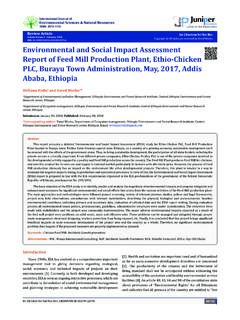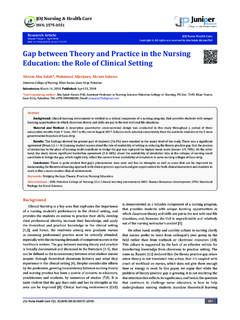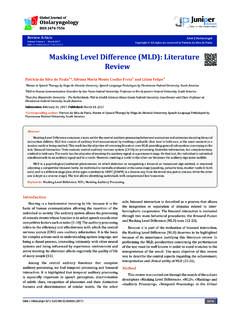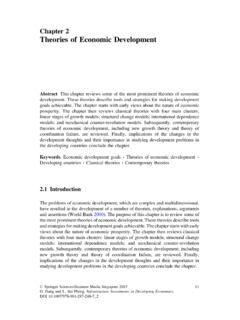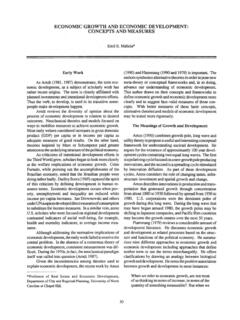Transcription of Theories and Models of Agricultural Development
1 Research ArticleVolume 1 Issue 5 - April 2018 Ann Rev ResearCopyright All rights are reserved by Udemezue JCTheories and Models of Agricultural DevelopmentUdemezue JC1* and Osegbue EG21 Staff of National Root Crops Research Institute, Nigeria2 Department of Agricultural Economics and Extension, Chukwuemeka Odumegwu Ojukwu University, NigeriaSubmission: February 09, 2018; Published: April 25, 2018*Corresponding author: Udemezue JC, Staff of National Root Crops Research Institute, Nigeria, Tel: ; Email: Agricultural DevelopmentAgriculture plays a key role in food security and economic Development . However, most of the world s population in rural areas depends directly or indirectly on agriculture for their livelihoods. Yet as the world s population increases and migration to towns and cities intensifies, so the proportion of people not producing food will grow [1].
2 Agricultural Development according to Nwachukwu [2], is a multi-sectional activity that support and promote positive change in the rural and urban areas. However, the main objectives of Agricultural Development are the improvement of material and social welfare of the people. Therefore, Agricultural Development is seen as synonymous with rural Development , the two terms are different but intrinsically related. Agricultural Development is a part of rural Development ; rural areas cannot develop without its agriculture being developed because about 90% of the rural dwellers are engaged in Agricultural practices as their major source of as a country seeks to become a leading economy in Africa and a major player in the world s economic and political affairs of which their 20-20-20 plan is their guideline.
3 To become a developed nation, Nigeria needs to speed up its economic growth by focusing on vital economic sectors like education, energy, agriculture and manufacturing. At this point in Nigeria s Development , the best approach is to focus on the Agricultural sector. By focusing on Agricultural Development , Nigeria can speed up its economic growth in the coming decade [3]. Agricultural Development can also address gender disparities. In Sub-Saharan Africa and South Asia, women are vital contributors to farm work, but because they have less access to improved seeds, better techniques and technologies, and markets, yields on their plots are typically 20 to 40 percent lower than on plots farmed by men. Addressing this gap can help households become more productive and reduce malnutrition within poor growth is seen as a long term rises in the capacity to supply increasingly diverse economic goods to its population.
4 It also entails a sustainable rise in national output with a manifestation of economic growth [4]. Therefore, the role of agriculture in transforming both the social and economic framework of an economy cannot be over-emphasized. It has been the source of gainful employment from which the nation can feed its teaming population, providing the nation s industries with local raw materials and as a reliable source of government to Adegoye & Dittah in Research Clue [4], a full developed economy, especially in Agricultural sector, means an increase in the production of export crops with an improvement in the quantity and grades of such export crops. However, for a country to industrialize, Agricultural output will be said to have acquired growth if agriculture can supply enough materials to agro-allied industries.
5 In the light of this, Reynulds in Research [4] opined that Agricultural Development can promote economic Development of underdeveloped countries in four different ways:Ann Rev Resear 1(5): (2018)00134 Abstract Agricultural Development is a sub-set of rural Development . However, rural areas cannot attain Development without its agriculture being developed because majority of the rural dwellers are engaged in Agricultural practices as their major source of income. The main objectives of Agricultural Development are the improvement of material and social welfare of the people. Therefore, creating a sustainable Agricultural Development path means improving the quality of life in rural areas, ensuring enough food for present and future generations and generating sufficient income for farmers.
6 Supporting sustainable Agricultural Development also involves ensuring and maintaining productive capacity for the future and increasing productivity without damaging the environment or jeopardizing natural resources. In the light of this, this paper employed available literature to review Agricultural Development and Theories of Agricultural Development such as frontier model, conservation model, the urban-industrial impact model, diffusion model and high-pay off input model. Keywords: Agricultural Development ; Theories and ofReviews and ResearchHow to cite this article: Udemezue JC, Osegbue EG. Theories and Models of Agricultural Development . Ann Rev Resear. 2018; 1(5): of Reviews and Researcha) By increasing the supply of food available for domestic consumption and release labour needed for industrial employment.
7 B) By enlarging the size of the domestic market for the manufacturing ) By increasing the supply of domestic saving and d) By providing foreign exchange earned by the Agricultural , creating a sustainable Agricultural Development path means improving the quality of life in rural areas, ensuring enough food for present and future generations and generating sufficient income for farmers. Supporting sustainable Agricultural Development also involves ensuring and maintaining productive capacity for the future and increasing productivity without damaging the environment or jeopardizing natural resources. In addition, it requires respect for and recognition of local knowledge and local management of natural resources, and efforts to promote the capabilities of current generations without compromising the prospects of future ones.
8 Consequently, economic and environmental sustainability, adequate farmers income, productive capacity for the future, improved food security and social sustainability are important elements of developing countries Agricultural Development [5]. Thus, When farmers grow more food and earn more income, they areable to feedtheir families, send their children to school, provide for their family s health, and invest in their farms and this makes their communities economically stronger and more stable for Agricultural developmentTheories of Agricultural DevelopmentThe main aim of Agricultural Development is the improvement of material and social welfare of the people. Therefore, it is often seen as integrated approach to improving the environment and well being of the people of the community [2].
9 The first step in the process of Agricultural Development is to abandon the view of agriculture in pre-modern or traditional societies as essential static. However the problem of Agricultural Development is not that of transforming a static Agricultural sector into a modern dynamic sector, but of accelerating the rate of growth of Agricultural output and productivity consistent with the growth of other sectors of a modernizing economy (https://ageconsearch-umn-edu/bitstream/ 135054/Fris-1972-11-02-245pdf). Therefore, any attempt to embrace a meaningful perspective on the process of Agricultural Development must abandon the view of agriculture in pre-modern or traditional society as essential static. Hence, a theory of Agricultural Development should provide insights into the dynamics of Agricultural growth , either into the changing sources of growth , in economies ranging from those in which output is growing at a rate of or less to those in which Agricultural output is growing at an annual rate of or more [6].
10 In view of the above, there are about five (5) general Models in the literature on Agricultural Development ; a) The frontier model b) The conservation model c) The urban-industrial impact model d) The diffusion model e) The high-pay off input model The Frontier Model The history expansion of the area cultivated or grazed in the western countries has represented the main way of increasing Agricultural production. However, the most dramatic example in western history was the opening up or creation of the new continents - North and South America and Australia - to European settlement during the 18th and 19th centuries [6]. These countries of the new continents became increasingly important sources of food and Agricultural raw materials for the metropolitan countries of the Western earlier times, similar processes had proceeded, though at a less dramatic pace, in the peasant and village economies of Europe, Asia and Africa.
